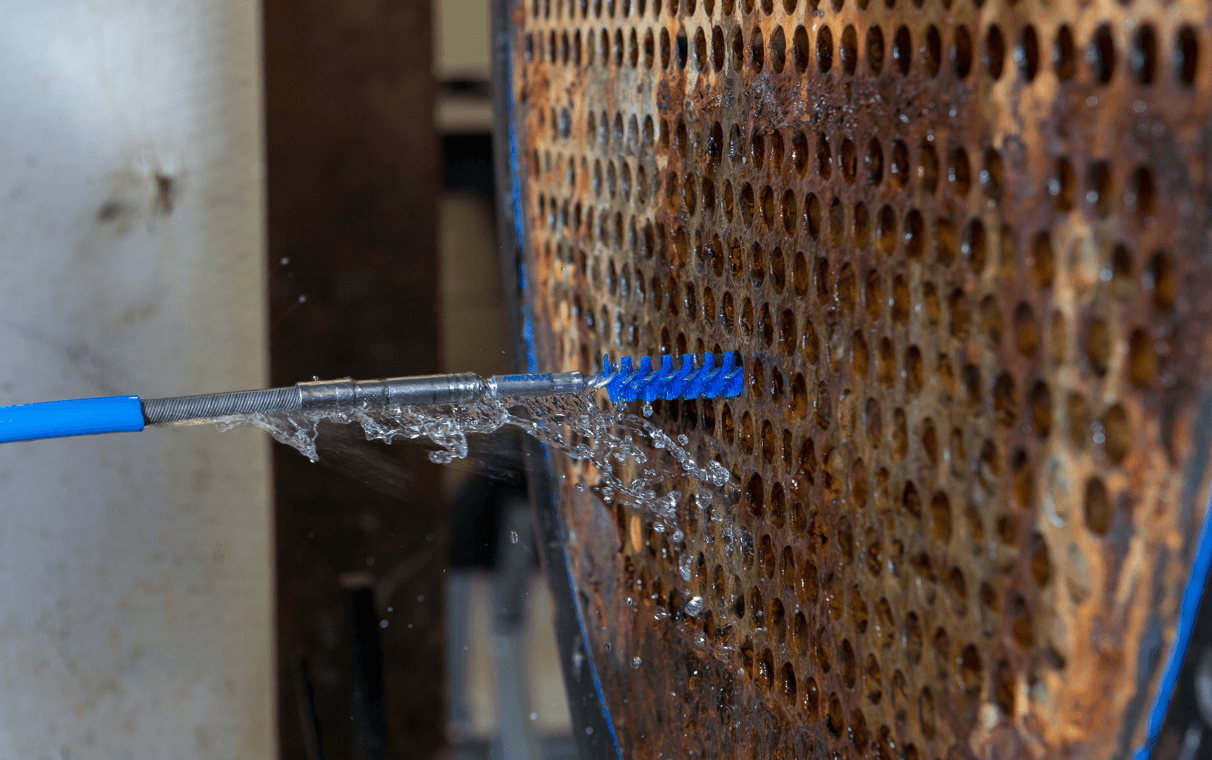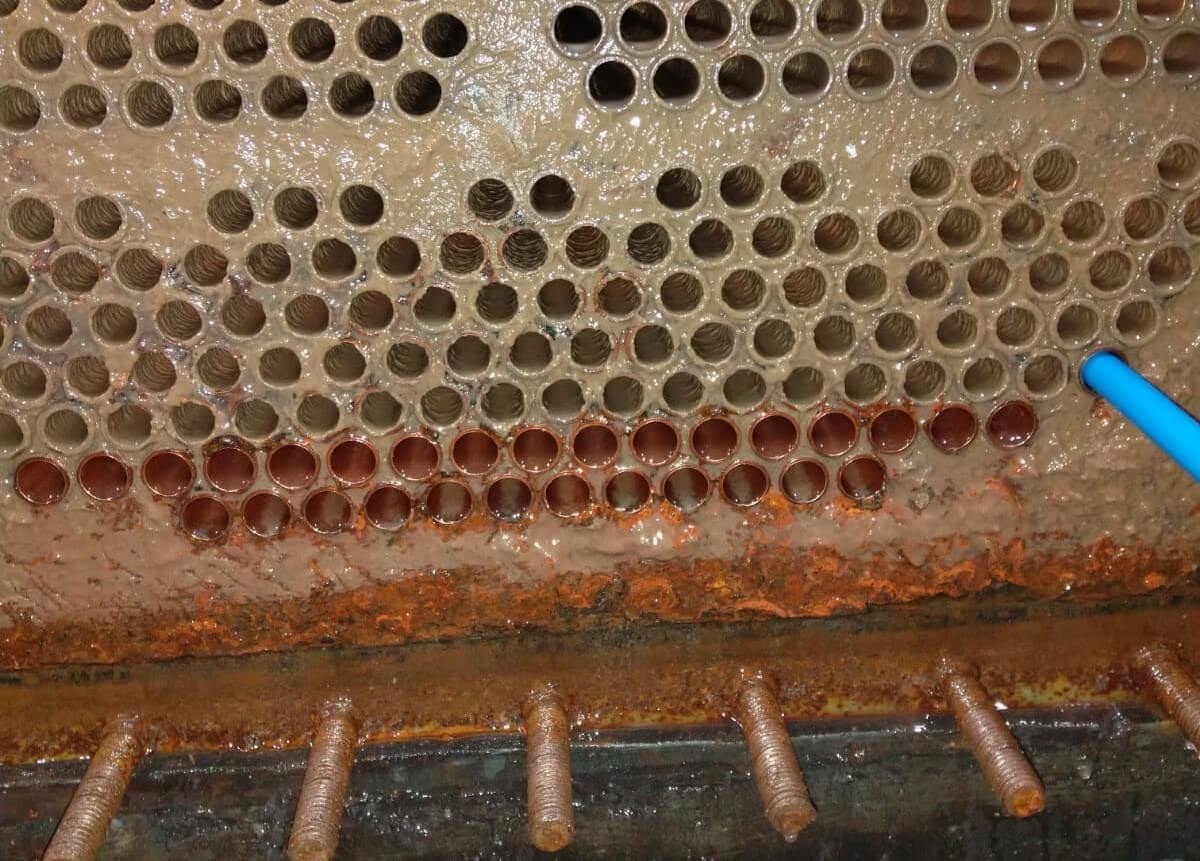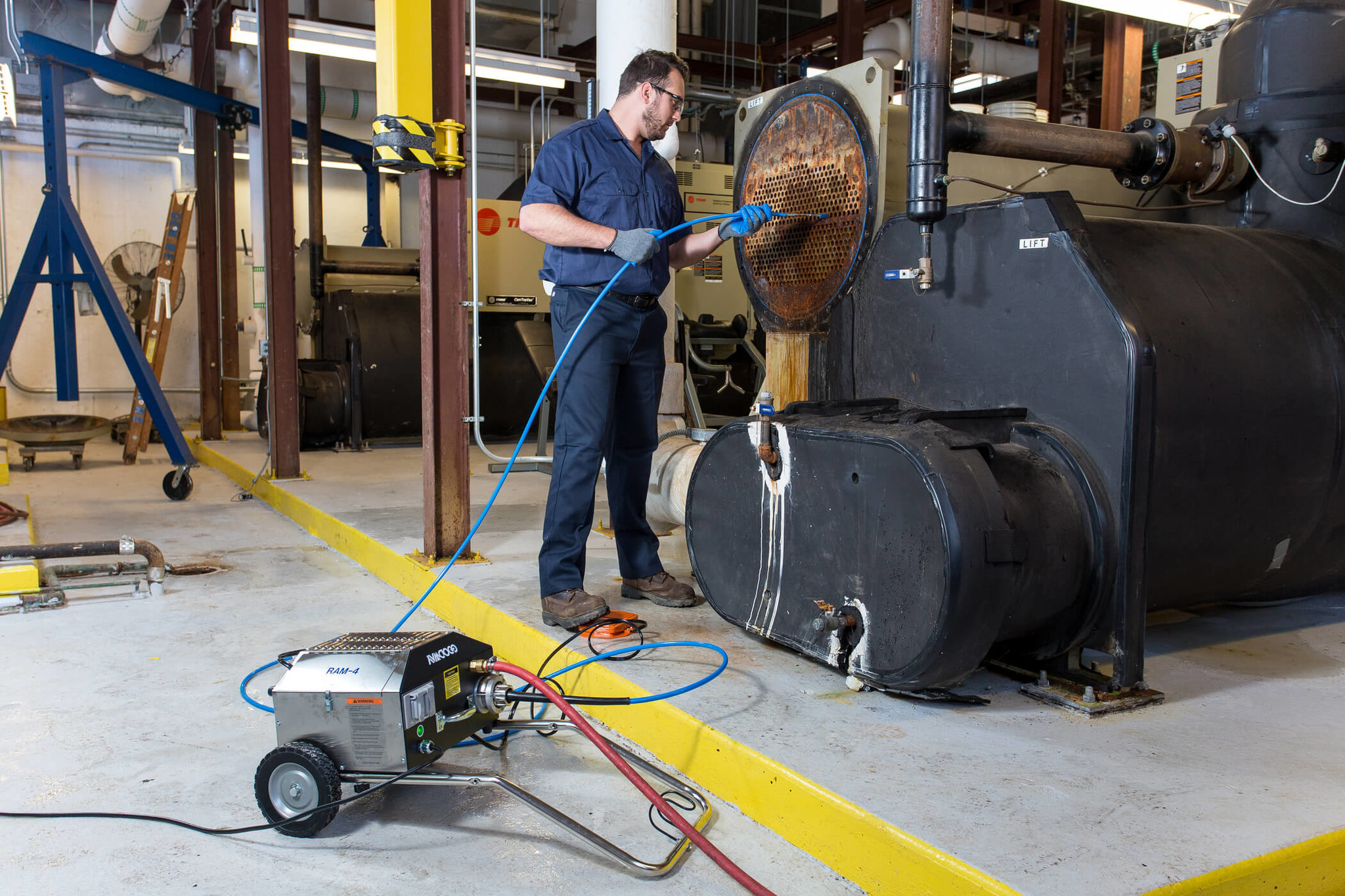Rotary Tube Cleaning
- Posted on
- By David Bokov
- 0

Tube cleaning with rotating brushes is a technique that is often used to clean (smaller) tube heat exchangers, such as water-cooled chillers. You can read more about the technique in this blog.
Rotary tube cleaning
Shell and tube heat exchangers, such as water-cooled chillers, can be found in almost every industry. These systems play an important role in the process and must therefore have optimum efficiency at all times. Correct and preventive cleaning of the heat exchanger tubes is therefore crucial. Various cleaning methods are available; low-pressure cleaning with rotating brushes is a technique that is often used to clean (smaller) tube heat exchangers.
Fouling in tubes
Tubular heat exchangers, also known as shell and tube exchangers, have many small tubes through which a liquid flows. In the case of water-cooled chillers, this water often comes from a cooling tower. Because the water contains particles and deposits, the tubes will become fouled over time. Depending on the type of deposit, the heat transfer can be (drastically) reduced. This is because fouling has an insulating effect, and therefore reduces the heat transfer between the 2 media. The most common problems due to fouled tubes are:
- Reduced efficiency: because the surface of the tubes is fouled, heat transfer between the 2 media becomes more difficult. This reduces the efficiency of the heat exchanger.
- Higher energy consumption: in order to continue to achieve the same efficiency level, connected compressors and pumps will have to run harder. As a result, energy consumption will rise (significantly).
- Shortened lifetime: fouled tubes with biological deposits and scaling can lead to under deposit corrosion, which shortens the lifetime of the tubes. In addition, connected systems, such as compressors and pumps, will need to work harder when tubes are fouled and dirty, adding to operating costs and wear and tear to those items.
The most common types of deposits in shell and tube heat exchangers are: algae, mud, sludge, bio-fouling (biofilm), rust and limescale. Depending on the type and degree of fouling, different types of brushes/tools can be used. If the (scale) deposit is very hard, a rotary tube cleaning may not be sufficient to fully remove the deposits. In this case it may be better to opt for a chemical cleaning by means of the cleaning-in-place (CIP) technique.

Applications and usage
Tube cleaning with rotating brushes/tools is mainly used for smaller tube heat exchangers, such as water-cooled chillers. This technique is most effective for light to medium types of deposits, such as; algae, sludge, mud, biological deposits and light scale. In most cases, the equipment is used to clean tubes between 7 and 28 millimeters. Think of products from well-known suppliers and manufacturers, such as: Trane, York, Carrier, McQuay, etc.
In the case of a water-cooled chiller that is connected to an open cooling tower, it is also wise to look at the condition of the cooling tower. If it is fouled, this will have a direct influence on the level of fouling within the condenser tubes of the chiller. Goodway Benelux offers various solutions for the cleaning of cooling towers. Check out the cooling tower cleaning page here, or contact our experts.

The cleaning technique
Tube cleaning with brushes is a relatively simple technique. The cleaning always consists of 3 parts: (1) tube cleaning machine, (2) flexible shaft, (3) cleaning brush or tool. The tube cleaning machine is powered by electricity or compressed air and then powers the flexible shaft. This will cause the cleaning brush or tool to rotate in the tube. A small amount of water is added to flush the loosened deposits out of the tubes. Because the rotating brush or tool rotates at high speed, friction is created in the tube. This friction causes deposits which have adhered to the tube wall to come loose. The most commonly used brushes are made of nylon material, making it possible to clean all kinds of tube materials without risk of damage.
Every shell and tube heat exchanger is different, which is why different variants of products and accessories are available. So it is important to know; how many tubes need to be cleaned, what the internal diameter of the tubes is, what the length of the tubes is, and what kind of fouling is in them. Based on this information, a cleaning package can be recommended.
Features of this technique
Rotary tube cleaning has a number of features and advantages over other cleaning techniques. You can find these features below.
- Easy to operate: the technique and equipment is easy-to-use. Even with minimal training, it is possible to effectively and quickly clean the tubes of a heat exchanger. This is often an advantage for companies that want to clean their own systems themselves.
- Interesting from a price point of view: the initial investment in a complete tube cleaning package is affordable when compared to other techniques or outsourcing cleaning activities. A tube cleaning machine will last for years, provided it is properly maintained. For future cleanings, it is only necessary to (occasionally) order a new flexible shaft and/or brushes. As a result, the total cleaning costs per system are very low.
- Safe cleaning: the technology is based entirely on the principle of low pressure. This means that no dangerous high pressure is needed for the cleaning process. The only moving part is the brush or tool and it is in the tube for almost the entire time. The safety for both the operator and the installation being cleaned is therefore very high.
- Low water consumption: the tube cleaning machines use approx. 7,5 liters of water per minute to flush away the loosened deposits and to cool the shaft core and brushes. Compared to traditional cleaning techniques, the water consumption of rotary tube cleaning is very low.
Tube cleaners and packages
Tube heat exchangers come in many different shapes and sizes. For this reason, Goodway Benelux offers different types of tube cleaning machines and accessories. In addition, there are also complete packages, developed to offer a total solution and to show exactly what is needed in terms of products and accessories. In most cases, the experts at Goodway Benelux recommend a cleaning package based on the application. Please contact customer service for this.

Comments
Be the first to comment...